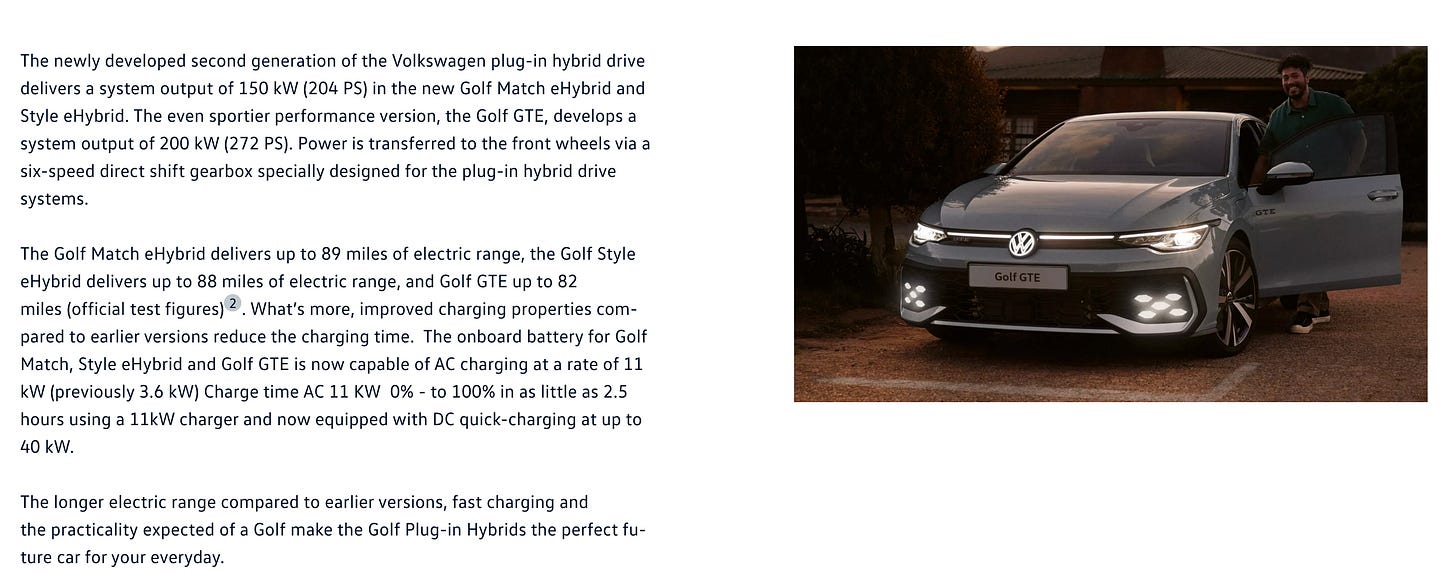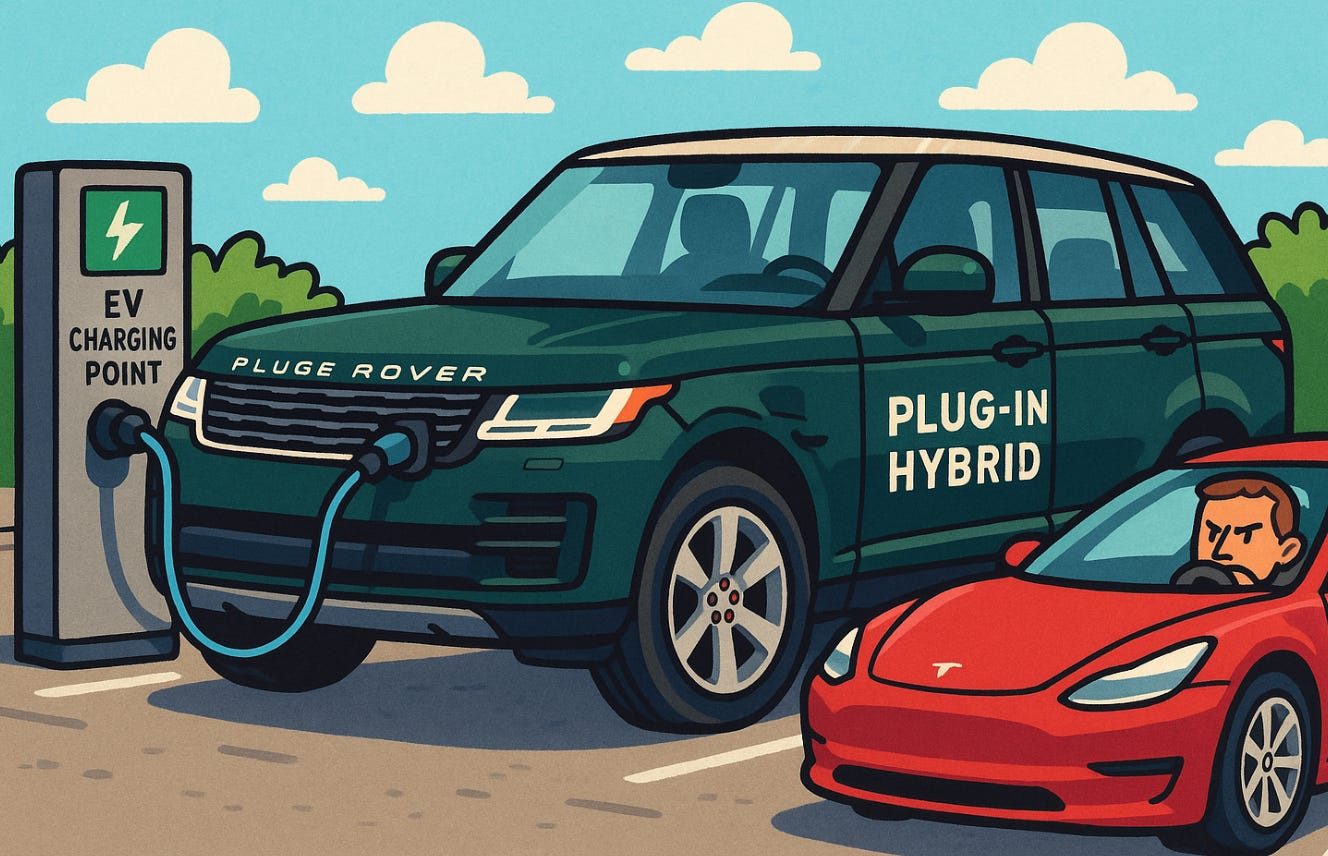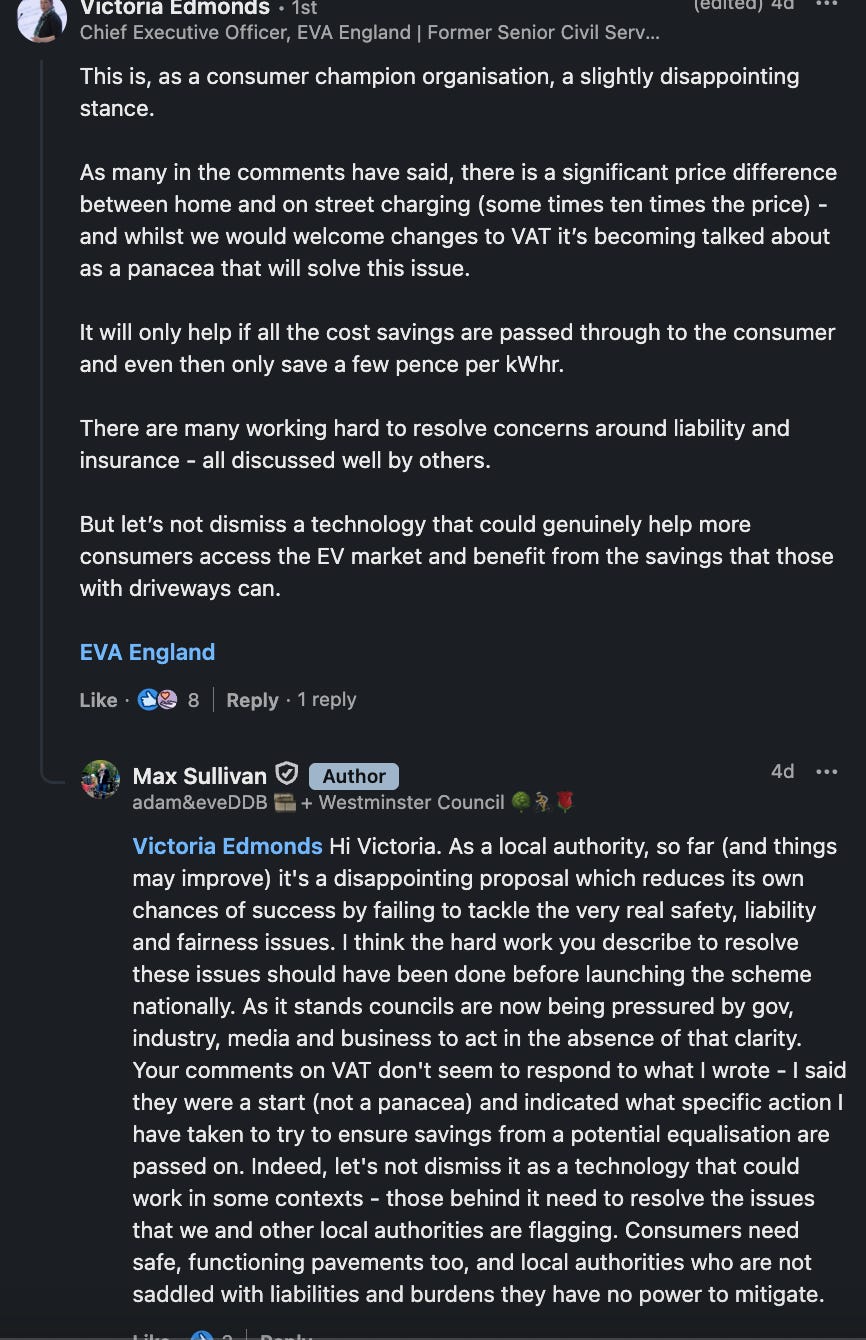Should we ban PHEVs from rapid chargers?
Plus, Westminster Council defies DfT scheme to boost cable gullys
Hello, I’m Tom Riley, and welcome back to The Fast Charge, a British EV newsletter.
I’ve been working on some big stories lately, so today’s free edition is more a collection of small news and some analysis. Top stories…
With one million plug-in hybrids expected on the road by Christmas, should we consider banning them from the UK’s fastest chargers?
Westminster Council defies Ministers by ruling out cable gullies; plus,
DVLA sells bulk vehicle data for £96,000 - and delivers it on a CD
As ever, if you have any comments or feedback, please reply to this email or message me on LinkedIn.
Analysis: Should we ban PHEVs from ultra-rapid chargers?
Summary: According to Zapmap, at present, there are some 882,000 Plug-in Hybrid EVs on British roads. The growth of PHEVs - which are cars that combine a normal combustion engine with a battery pack for limited EV-only driving - have been on the rise in recent years and, following the recent changes to the ZEV mandate, will likely be an important part of people’s transition to full EVs.
By my analysis... If the current growth continues, there will be one million PHEVs registered in the UK by the end of 2025.
In principle... This is not a bad thing. Yes, we EV folk know that, fundamentally, you and your wallet are better off going straight into a fully electric car. However, while myths still surge all about, PHEVs will be important in getting millions of people familiar with life with a plug. Likewise, while this also doesn’t make sense to me, many new PHEVs available now have much bigger ranges - most are over 50 miles - whereas in years previous they’ve been as low as 15 miles.
Though... Herein lies a problem. Many of these new PHEVs can increasingly use DC chargers, as they have the correct ports, and their slightly bigger batteries can sometimes accept up to 50kW speeds. For example, the plug-in Range Rover, VW Golf, or the Jaecoo 7 (there are many more). That’s both great but, to me at least, also quite concerning…
Why? Let’s start with some context. A few weeks ago, I reported in this newsletter that charging networks were likely going to be under fresh pressure to install tens of thousands of chargers over the next year, especially due to the new grant. This is because, at present, my figures show there are about 19 EVs to each public charger (of any speed). And when it comes to rapids (ones over 50kW), it’s 95 cars per device. I concluded, to maintain this level, networks will need to install 25,421 chargers in the coming 12 months at the very least.
But... If you throw millions of modern PHEVs into the mix over the coming years, that formula might become increasingly harder to meet.
My concern is this. PHEV owners have to recharge more often. That’s because, while their battery sizes are bigger than early models, it’s nowhere near comparable to fully electric equivalents. And with DC charging capacity being added in, could that mean more of our rapid charging hubs end up with PHEV visitors - possibly blocking fully electric cars in the process?
I’ve done the maths... And when you combine both the current PHEV population with the current BEV population, you end up with 2,474,530 plug-in vehicles. That means there are presently 30 BEVs and PHEVs to each charger at any speed. But when it comes to rapid devices, the addition of PHEVs turns the 95 vehicles per device for solely BEVs up to 148 when covering both types. That’s a 55% jump.
Clearly... There isn’t an issue right now. But that’s why I’m bringing this up, Mum. Because as carmakers sell more PHEVs up to 2035, it certainly looks like it could become an issue in the future. By Summer next year, on the current trajectory based on the last two quarters, we should expect to have 300,000 new PHEVs on UK roads - alongside 400,000 (or maybe even more) genuine EVs. And given we expect many of these buyers to increasingly be in the “I have no driveway” column, maybe we need to think ahead today.
My idea is this... let’s ban PHEVs from using chargers at Motorway Service Areas. To me, it seems fair. And, if I were the operator of a bank of pricey 350kW chargers, I’d be wanting a high turnover rate of EVs, not having my bays blocked up by Mr and Mrs Soho House in their PHEV Wayne Rover.
I’m conscious that I could be overly worrying about this. So, I’ve also sought the views of some experts.
Firstly, I asked the RAC Foundation for their thoughts, especially as they’d previously raised similar concerns in 2018. Director of the RACF, Steve Gooding, commented:
“At the RAC Foundation, we have long recognised the potential problem of PHEV 'bed blocking' rapid chargers, but we also observe that not bothering to recharge PHEVs is also a thing. Given that, for environmental reasons, it is necessary to maximise the Utility Factor (the amount that PHEVs are driven on Battery rather than ICE) doing anything to hinder public charging of PHEVs would seem counter to the overall mission behind the push to electrify.
“Most PHEVs with DC charge connectors can now charge at rates that are not unusual for many, particularly older or cheaper fully electric cars, given that they have smaller batteries this means that they are not going to be occupying chargers for very long - unless they overstay. Problems of overstaying apply equally to full BEVs, and would probably be much better solved through software issues (making sure vehicles are disconnected fully at 100% or even preventing charging over 80% at busy times) or through appropriate incentive (penalty) charges."
Elsewhere, when I asked Dan Caesar, CEO of the group Electric Vehicles UK, he took a different view, saying:
“As long term battery EV drivers we believe it makes sense for BEVs to be prioritised over PHEVs at rapid charging locations. PHEVs are really at their best doing short, local, electric mode trips, not least as carrying two drivetrains long distances is inefficient and expensive. While PHEVs are an important stepping stone to plugging in, for those fortunate enough to have a driveway, BEVs are a cost-saving no-brainer over all other powertrains. And most of those that think a PHEV is for them would probably be better to buy a battery EV. This would be a sensible nudge by motorway services and prevent their chargers from being clogged by electrified combustion vehicles.”
What’s your view on this topic? Are you being kept awake by the thought of Sloane Rangers blocking your EV chargers? Let me know!
News: Westminster Council defies Ministers by ruling out gullies
Summary: Only a few weeks after Whitehall announced a new £25 million scheme to support councils on the installation of EV charging gullies, a LinkedIn post by a Westminster Council member says they’ve ruled the approach out - even though the Department for Transport has allocated them £88,000 to deliver it.
Details... Max Sullivan, a Westminster Councillor responsible for Transport and Highways, wrote on LinkedIn last week that the local authority “won't cut up Westminster pavements to enable cross pavement/gully charging of private EVs from domestic electricity supplies.”
His post included three reasons why... Firstly, concerns about the safety of cables. Secondly, concerns about the maintenance of the gullies. And, finally, there is no guarantee that the person can park their car next to their installed gully.
As you can imagine, this went down badly amongst many in the industry. Vicky Edmonds, CEO of EVA England, commented underneath the post saying it was a “disappointing stance” and asked that the technology not be ruled out, due to risks around liability being worked on.
To me... I can see why Westminster in particular wouldn’t go with this approach, given the scale of its charging network, but an outright refusal does feel premature, and it sets a bad example for other local councils who’ll have a lot less EV knowledge than Westminster does.
At what point is someone in OZEV going to grab the bull by the horns on this policy? I’m astounded councils weren’t asked to input on its feasibility BEFORE they were put in charge of it. Mad, and I suppose there goes my idea for one on Downing Street.
Did you know this about the DVLA? 😬
Last week, I was tipped off that the Driver and Vehicle Licensing Agency (DVLA) sells UK vehicle data in bulk. I naively had assumed it was all free. But, after checking for myself, it turns out, for the eyewatering price of £96,000 a year (or £8,000 per month), they will send you data on 46 million vehicles registered in the UK. This includes everything from a vehicle’s registration, MOT details, colour, fuel type, wheel plan - absolutely all but the name of the owner.
HOWEVER... What I find utterly bizarre in the year 2025 is that, if you buy all that data, it’s given to you by the DVLA on a CD - sent by a secure courier. That must be the most expensive disc in history. Dear god, I hope they don’t use EVRI.
👉 I understand DVLA is looking at a replacement ‘electronic data transfer system’ - which sounds a little bit like, err, the internet? - but for now it remains a CD.
Other quick EV hits…
🚚 This week, DfT announced the plug-in van and truck grant has been extended to at least 2027. Read more.
🚘 DfT has also listed more models eligible for the EV grant, including a VW ID.3 and the Cupra Born. See here. However, there are still no EVs listed as eligible for the top grant worth £3,750.
🔌 Outside Westminster’s decision (above), there’s been lots of interesting cable gully-related news this past week. Including... A new report by Motability Operations calls on the new products to be inclusive, following testing of current solutions on offer. Also, DfT has now made its cable gully grant allocations for local authorities. See the list here.
🛜 According to a procurement advert by Coventry Council, the area is looking to install four new wireless chargers to be fitted in disabled parking bays in the city centre. It’s grant-funded. Very interesting given the cable gully news. Read more.
🚆 I ended up in a hole on the procurement website... Also looks like Network Rail is seeking to install a mix of EV chargers at 45 sites across Wales and the West of England. They’re looking for chargers with speeds between 22 kW to 150 kW, with the number of chargers per site varying between 2 and 30. So, that could be anywhere from 90 to 1,350 chargers. Woof. See here.
⚡️ Three former members of Tesla’s UK Supercharger team have secured £60m to develop rapid charging hubs in UK cities. Read more.
👍 Car dealer Arnold Clark now operates 50 charging hubs across the UK, and they’re now all open to the public. Read more.
💸 Transport for Scotland has allocated £3m to help bring more EV chargers to the remotest parts of the country. Read more.
🚎 Salisbury bus depot is getting 12 new EV chargers courtesy of EO Charging as the local council readies for 23 electric buses to arrive in 2026. Read more.
🚙 Charging network Zest has launched a new 16 bay ultra-rapid charging hub near Birmingham’s Jewellery Quarter. Read more.
😬 Finally… fun to see the MailOnline pick up on my story about government Red Boxes getting driven around VIP style. Read more.





Tom, a key aspect that you've missed is the economic argument. if we take Petrol at £1.35 litre and a PHEV with say 45mpg (10 miles per litre) on petrol and say 3.4 m/kWh indicated on electricty (which is 3m/kWh of elecricity paid for when charging losses are included) The "break even" for EV driving to be cheaper than petrol is at 40ppkWh. Zapmap latest data says rapid/ultra rapid is on average 76ppkWh so almost twice as expensive as running on petrol. There is therefore no need to "ban" as there is no incentive for economically literate PHEV drives to use the (expensive) rapid chargers or indeed most public chargers, as they have the benefit of being able to run long distances at lower cost. My 11 yrs with an Ampera has show the sweet spot for EREV (PHEV) to be always charged at home and most journeys less than 50 miles round trip typical user with a few longer journey and no angst of charger price/avaiability or (as i did this week) getting stuck on a charger that wouldnt release the cable. For people with home charging the capable PHEV can be a very compelling option and doesn't encroach on the public estate needed for BEV.
They way PHEVs and more specifically EREVs are evolving, the obvious answer is no we shouldn't. Consider for example the Zeekr 9X with its 70kWh battery, and 10-80% 11 minute charging time (267kW average), which is faster than most EVs. There are plenty of PHEVs that can charge faster than an eCorsa or Niro.
The problem is largely self solving. Owners of slow charging PHEVs just aren't going to be paying the same price as petrol to charge for ages at a motorway services just to get 30 miles. Even those who can go 200 miles probably won't charge en route unless it is at a cheap site like Ionity, and we should probably encourage that as it is better for the environment. I ignored Tesla because they don't support 800V cars and I doubt the DC to DC converter in a PHEV will deliver a decent speed.